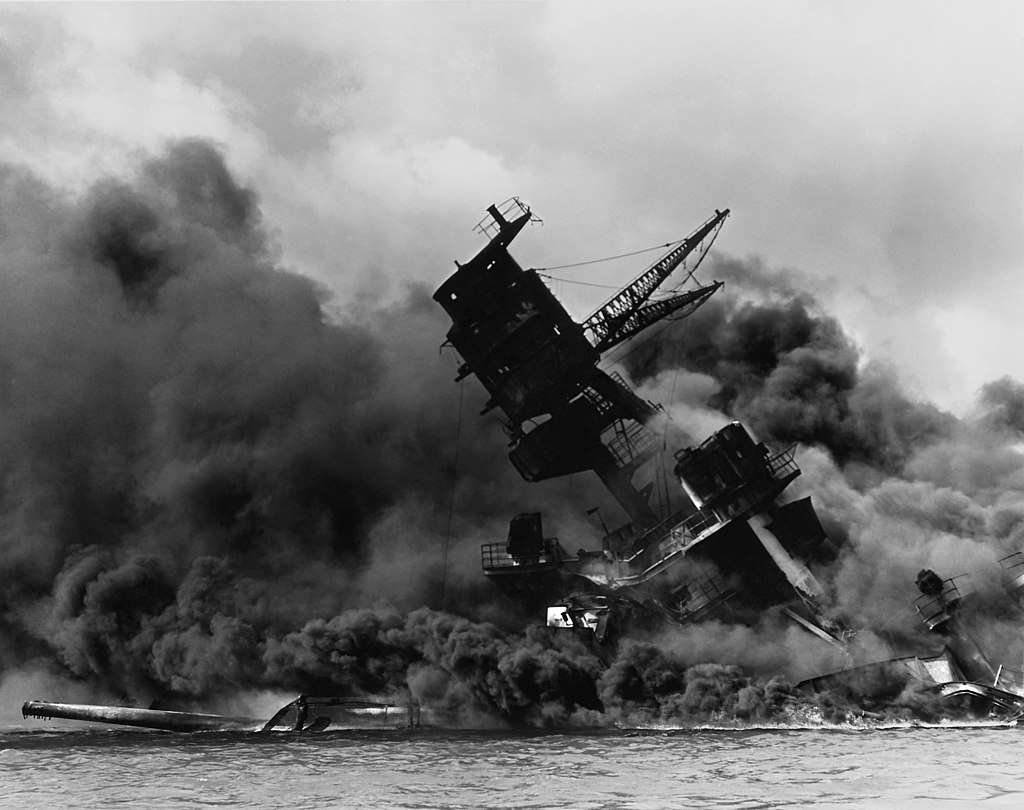
The USS Arizona – A Symbol of Valor and Sacrifice
The USS Arizona, one of the most recognizable names in American naval history, serves as an emblem of valor, sacrifice, and resilience.
The USS Arizona, commissioned in 1916, was a super-dreadnought battleship that represented a pinnacle of American naval architecture during the early 20th century.
Its tragic sinking during the surprise Japanese attack on Pearl Harbor on December 7, 1941, resulted in the greatest loss of life on any U.S. warship in history and marked the United States’ entry into World War II.
Today, the sunken remains of the USS Arizona and its memorial stand as poignant symbols of sacrifice and bravery, attracting over a million visitors annually.
The Birth Of The USS Arizona
As the 20th century unfolded, the global community was swept into an era of geopolitical tensions and rivalries. Amidst this, the United States of America recognized the need to fortify its defenses.
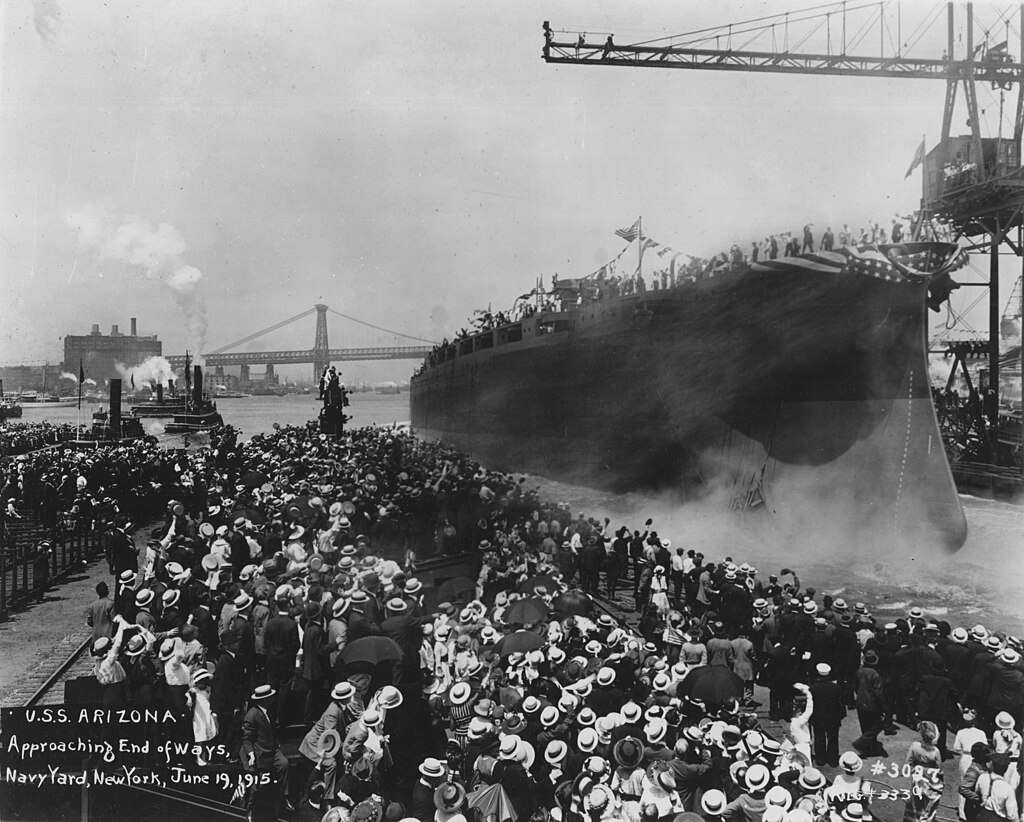 Launching the USS Arizona in 1915.
Launching the USS Arizona in 1915.
The USS Arizona was laid down on March 16, 1914, in the historic Brooklyn Navy Yard.
Named after the 48th state, the Arizona was part of the Pennsylvania class of ‘super-dreadnought’ battleships, a class that embodied the latest advancements in naval warfare technology and design.
The construction of the USS Arizona coincided with a period of rapid technological changes. It represented the United States’ ambition to create a formidable naval fleet that could compete with the major maritime powers of that time.
The focus was on building heavily armed and armored battleships that could meet any naval challenge head-on. This philosophy was encapsulated in the design of the USS Arizona, which represented the pinnacle of American naval engineering when it was commissioned on October 17, 1916.
Architectural Marvel of Its Time
The USS Arizona’s design and construction incorporated cutting-edge technology and a forward-thinking strategy, reflecting the evolving trends in naval warfare and positioning the United States as a major maritime power.
At an imposing length of 608 feet and a breadth of 97 feet, the Arizona was a behemoth, engineered to showcase the might of the American navy.
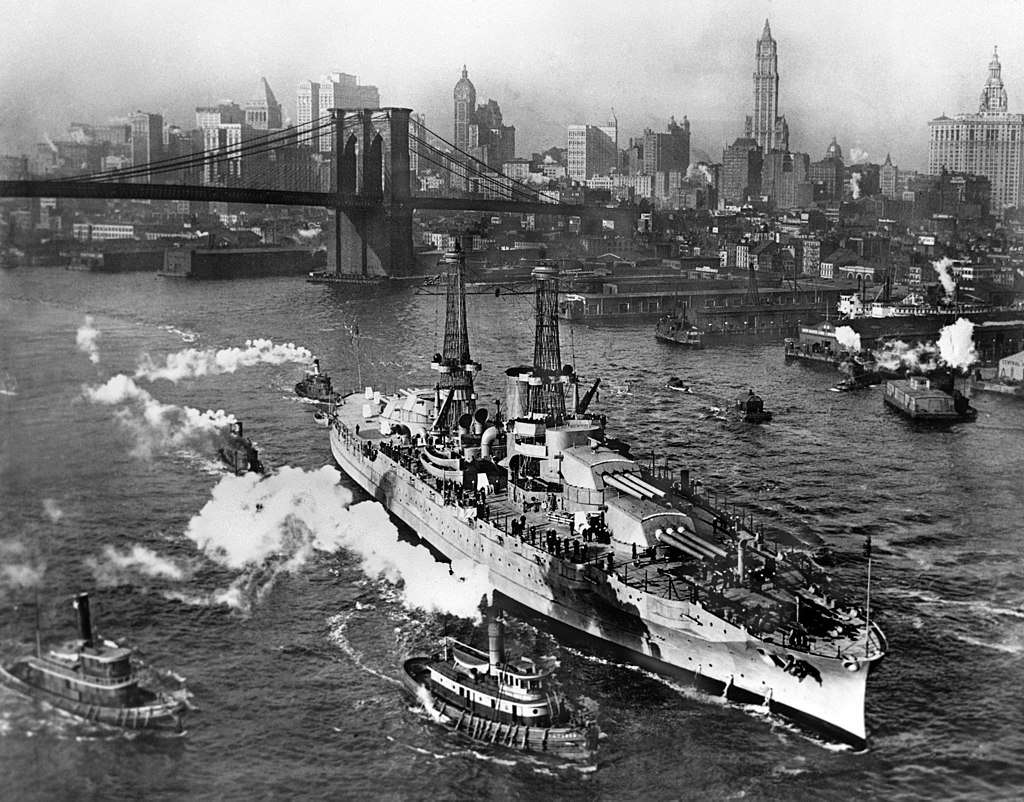 The USS Arizona in New York City, 1916.
The USS Arizona in New York City, 1916.
It was armed with a formidable arsenal of twelve 14-inch guns in four triple turrets and twenty-two 5-inch guns. This massive firepower, combined with the ability to launch shells over 20,000 yards, rendered the Arizona a formidable force on the seas.
The battleship’s armor, too, was noteworthy. With a belt armor reaching up to 13.5 inches thick and turret armor up to 18 inches, the Arizona was designed to withstand substantial enemy fire.
A particularly innovative feature of the USS Arizona was its inclusion of aircraft technology. At a time when the concept of the aircraft carrier was still in its infancy, the Arizona incorporated aircraft launching capabilities.
Equipped with three catapults for launching spotter planes, the Arizona could extend its sight far beyond the horizon, scouting for enemy ships and providing accurate target data for its guns.
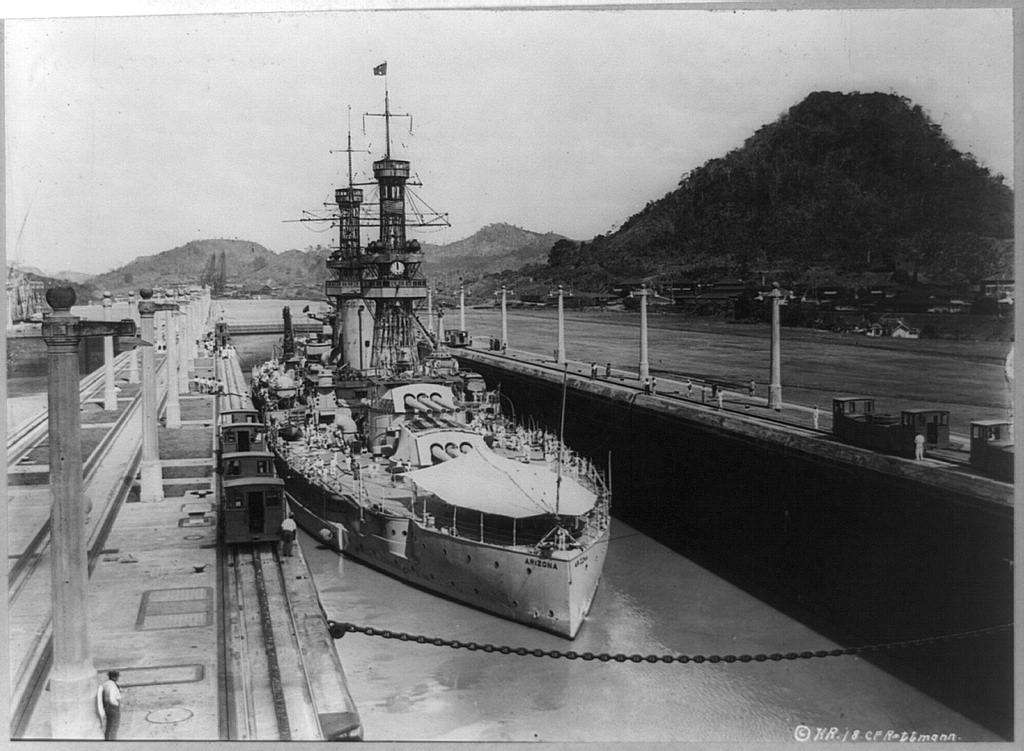 USS Arizona in one of the locks in the Panama Canal, 1921.
USS Arizona in one of the locks in the Panama Canal, 1921.
This forward-thinking approach allowed the USS Arizona to adapt to the evolving trends in naval warfare, shifting from pure surface engagements towards a new age where air power would become increasingly vital.
Moreover, the ship was also designed with crew comfort in mind. It boasted relatively spacious quarters, a medical dispensary, a cobbler shop, and even a tailor shop.
The Sinking of the USS Arizona
The sinking of the USS Arizona during the attack on Pearl Harbor stands as one of the most heart-wrenching moments of World War II.
In those frantic and terrifying moments, the battleship and much of her crew were lost, marking a devastating chapter in American naval history.
On the morning of December 7, 1941, Pearl Harbor was shrouded in the peaceful calm of a Sunday.
The serenity was violently shattered at 7:55 am when waves of Japanese aircraft, launched from six aircraft carriers stationed northwest of Hawaii, commenced an unprovoked and surprise assault on the harbor.
The attack targeted the Navy’s aircraft carriers and fleet, with eight battleships, including the USS Arizona, stationed at Battleship Row.
In the onslaught that followed, the USS Arizona became a prime target for the Japanese bombers.
Approximately 15 minutes into the attack, a 1,760-pound armor-piercing bomb, dropped from a Japanese Nakajima B5N2 ‘Kate’ torpedo bomber, found its mark on the Arizona.
The bomb struck the deck and penetrated into the forward magazine, where the ship’s ammunition was stored.
The resulting explosion was cataclysmic.
 The USS Arizona after the attack on Pearl Harbor.
The USS Arizona after the attack on Pearl Harbor.
It caused a massive fireball that was seen across the harbor, and the shockwave from the detonation lifted the 31,400-ton battleship out of the water.
Within mere seconds, the forward part of the ship was obliterated, a gaping hole marking where it once stood. The explosion tore the ship apart, igniting fires that would continue to burn for two days.
The USS Arizona sank in just nine minutes, its superstructure collapsing and its hull settling into the mud of the harbor.
Tragically, out of the ship’s crew of approximately 1,512 men, 1,177 perished. Many of these men were trapped inside the sinking battleship, their escape routes cut off by flames, twisted metal, and rapidly rising water.
After The Attack
Following the devastating attack on Pearl Harbor and the sinking of the USS Arizona, the battleship lay at the bottom of the harbor as a grim reminder of the tragedy.
The sunken vessel, still visible above the waterline, was deemed irreparable and was never raised or refloated. It was subsequently decommissioned on December 29, 1941.
In the immediate aftermath of the attack, the salvage operations focused on recovering anything of value from the ship and making the harbor usable again.
Notably, the USS Arizona’s superstructure, including the masts and the main battery turrets, were removed and repurposed. Two of the Arizona’s three main battery gun turrets were reinstalled at the entrance of Pearl Harbor as part of Battery Pennsylvania, where they provided coastal defense during World War II.
Despite the salvage operations, the remains of over 900 sailors and marines are still entombed within the sunken battleship, their final resting place marked by the rusting hull of the USS Arizona.
Oil from the ship continues to leak into the harbor, referred to as the “tears of the Arizona” or “black tears,” serving as a haunting reminder of the lives lost.
The USS Arizona Memorial
The USS Arizona Memorial is a monumental tribute to the courage and sacrifice of the men who served on the battleship during the attack on Pearl Harbor.
The memorial is not just a structure, but a sacred site, a testament to the resilience of the human spirit, and a poignant reminder of one of the most tragic events in American military history.
The journey towards establishing a fitting tribute to the fallen began in 1949 with the formation of the Pacific War Memorial Commission. This marked the beginning of a long and challenging journey involving fundraising, design selection, and construction.
Designed by architect Alfred Preis, the memorial is a beautiful and evocative piece of architecture.
Its design has symbolic significance – the structure has a sag in the center but is strong and vibrant at the ends, representing the initial defeat and ultimate victory of the United States in World War II. The 184-foot long structure straddles the sunken hull of the Arizona without touching it, allowing visitors a direct connection to the ship and its story.
Visitors to the memorial begin their journey at the Pearl Harbor Visitor Center, where they are educated about the historical context of the attack and the subsequent entry of the United States into World War II.
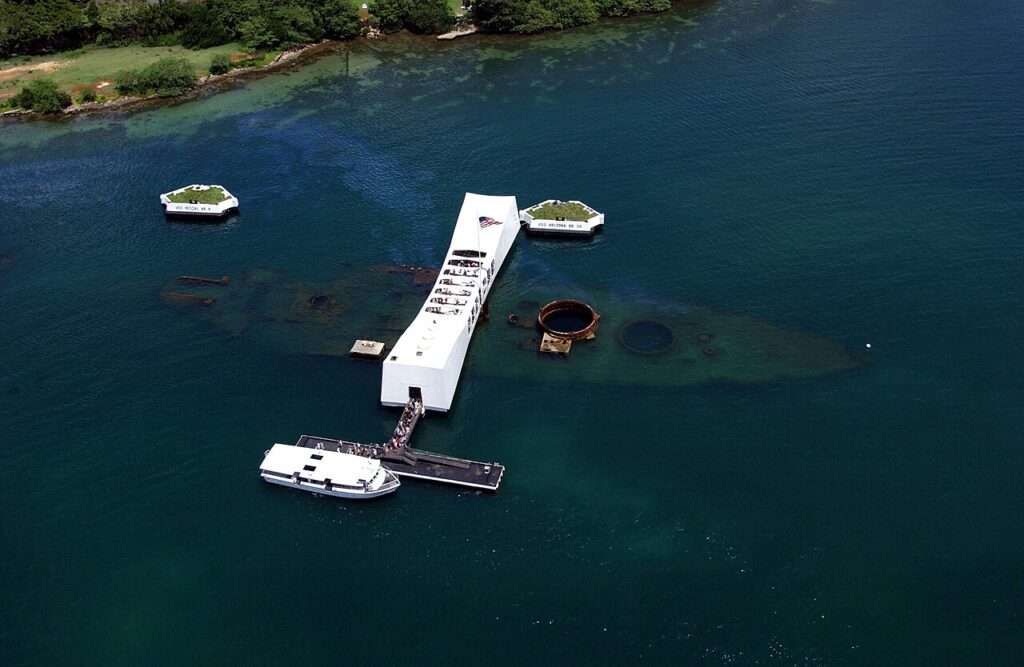 The USS Arizona memoria.
The USS Arizona memoria.
Following a short boat ride, they are taken to the memorial itself. The site consists of three main sections: the entry room, where visitors are introduced to the ship and its crew; the assembly room, an open area for contemplation and observation of the sunken battleship; and the shrine room, where the names of the fallen sailors and marines are engraved on a marble wall.
Perhaps the most poignant aspect of the USS Arizona Memorial is the constant seepage of oil from the wreckage of the ship. Even more than eight decades after the attack, the “tears of the Arizona” or “black tears” continue to rise to the surface, a somber reminder of the events of that fateful day and a tribute to those who perished.
Every year, the memorial receives over a million visitors, including veterans, families of the fallen, school groups, and those interested in understanding the history. The USS Arizona Memorial has transcended from being merely a monument to becoming a place of remembrance, reflection, and learning.
In essence, the USS Arizona Memorial symbolizes the enduring legacy of bravery, sacrifice, and unity that emerged from the devastating events of December 7, 1941. It serves as a powerful reminder of the events that changed the course of American history, and the world, forever.
The USS Arizona is more than a ship; it is a testament to the bravery of the men who served aboard her and the sacrifice they made for their country. From its inception as a symbol of naval prowess to its final resting place at Pearl Harbor, the USS Arizona encapsulates a critical period of American history.
As we remember the events of World War II, the USS Arizona Memorial continues to resonate as a monument to peace, a testament to valor, and a symbol of national remembrance.
News
The Hanging Temple: China’s 1,500-Year-Old Cliffside Marvel of Faith and Engineering
The Hanging Temple: China’s 1,500-Year-Old Cliffside Marvel of Faith and Engineering Perched precariously on the cliffs of Mount Heng in Shanxi Province, China, the Hanging Temple, also known as Xuankong Temple, Hengshan Hanging Temple, or Hanging Monastery, is an architectural…
The Willendorf Venus: A 30,000-Year-Old Masterpiece Reveals Astonishing Secrets
The Willendorf Venus: A 30,000-Year-Old Masterpiece Reveals Astonishing Secrets The “Willendorf Venus” stands as one of the most revered archaeological treasures from the Upper Paleolithic era. Discovered in 1908 by scientist Johann Veran near Willendorf, Austria, this small yet profound…
Unveiling the Maya: Hallucinogens and Rituals Beneath the Yucatán Ball Courts
Unveiling the Maya: Hallucinogens and Rituals Beneath the Yucatán Ball Courts New archaeological research has uncovered intriguing insights into the ritual practices of the ancient Maya civilization. The focus of this study is a ceremonial offering found beneath the sediment…
Uncovering the Oldest Agricultural Machine: The Threshing Sledge’s Neolithic Origins
Uncovering the Oldest Agricultural Machine: The Threshing Sledge’s Neolithic Origins The history of agricultural innovation is a fascinating journey that spans thousands of years, and one of the earliest known agricultural machines is the threshing sledge. Recently, a groundbreaking study…
Nara’s Ancient Sword: A 1,600-Year-Old Protector Against Evil Spirits
Nara’s Ancient Sword: A 1,600-Year-Old Protector Against Evil Spirits In a remarkable discovery that has captured the attention of archaeologists and historians alike, a 7.5-foot-long iron sword was unearthed from a 1,600-year-old burial mound in Nara, Japan. This oversized weapon,…
The Inflatable Plane, Dropped Behind the Lines for Downed Pilots
Experimental The Inflatable Plane, Dropped Behind the Lines for Downed Pilots The Inflatoplane from Goodyear was an unconventional aircraft developed by the Goodyear Aircraft Company, a branch of the renowned Goodyear Tire and Rubber Company, also famed for the Goodyear…
End of content
No more pages to load











